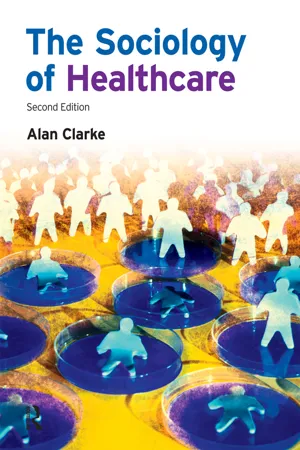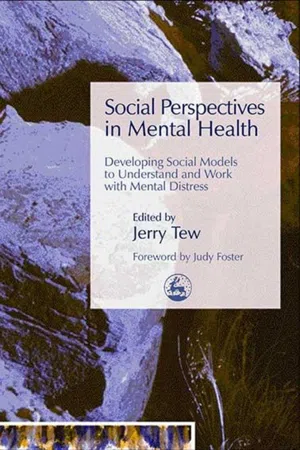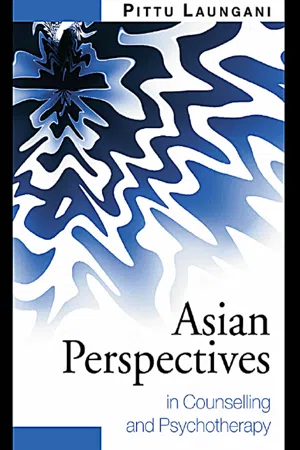Psychology
Psychological Perspectives in the Treatment of Disorders
Psychological perspectives in the treatment of disorders refer to the various theoretical frameworks and approaches used by psychologists to understand and address mental health issues. These perspectives include psychodynamic, behavioral, cognitive, humanistic, and biological perspectives, each offering unique insights into the causes and treatment of psychological disorders. By integrating these perspectives, psychologists can develop comprehensive and personalized treatment plans for individuals with mental health concerns.
Written by Perlego with AI-assistance
Related key terms
9 Key excerpts on "Psychological Perspectives in the Treatment of Disorders"
- eBook - ePub
- Matt Field, Sam Cartwright-Hatton(Authors)
- 2015(Publication Date)
- SAGE Publications Ltd(Publisher)
2 How are Psychological Disorders Treated?General introduction
Mental health professionals treat the symptoms of psychological disorders in a multitude of ways. This chapter will outline some of the most common ways in which they work. We will begin with a look at the debate surrounding the use of medication versus psychological techniques. After this cursory overview of the medical approach, we will then focus on approaches that are taken by psychologists (well this is a psychology book, after all). We will discuss preventative approaches, which have become an increasing focus in recent years (although still not nearly enough), and also discuss treatment approaches that are used when symptoms are already present. Within both prevention and treatment work there are many ways of working. Psychologists may work with individual clients or with groups. They may use a manual-based ‘package’, which is applied to the client with a minimum of tailoring, or they may use the gold-standard, formulation-based approach which is custom-built for each client. Psychologists also work from a number of theoretical perspectives, including cognitive-behavioural and psychodynamic. They may specialise in the treatment not just of adults, but also of children and adolescents, people with learning disabilities, older adults, and other specialist groups.This chapter will give a brief introduction to all of these approaches, but thenceforth both this chapter and the rest of the book will give most attention to what typically happens in clinics (as opposed to research trials). This is the individual treatment of one individual, using a selection of techniques that are hand-picked for that client, based on a thorough assessment of their needs. Because the bulk of the scientific evidence base is devoted to cognitive-behavioural theories and treatments, it is these that we will focus on in the rest of the book. Although there is now a growing literature on the treatment of children, families, couples, people with learning disabilities and older adults (amongst others), this chapter, and most of those that follow, will focus largely on the treatment of individual, non-disabled adults. We will also give some thought as to how researchers evaluate the usefulness of psychological therapies. Finally, we will examine the ethical framework within which all psychologists are expected to work. - eBook - ePub
Understanding Psychology for Medicine and Nursing
Insights and Applications
- Mohamed Ahmed Abd El-Hay(Author)
- 2019(Publication Date)
- Routledge(Publisher)
Biological perspective (medical or disease model): this explains psychological disorders in terms of particular disturbances in the anatomy and chemistry of the brain and in other biological processes, including genetic influences (e.g., Plomin & Asbury, 2005; Plomin & McGuffin, 2003). The medical model gave rise to the idea that abnormality is a mental illness. Neuroscientists and others who adopt a neurobiological model study the causes and treatment of these disorders as they would study any physical illness, assuming that problematic symptoms stem primarily from an underlying illness that can be diagnosed, treated, and cured. Researchers using this approach look for genetic abnormalities that may predispose a person to develop a particular mental health problem by affecting the functioning of the brain. They also look for abnormalities in specific parts of the brain and dysfunction in neurochemical systems in the brain and other parts of the body. Proponents of this perspective generally favor the use of drugs to treat mental health problems.2. Psychological perspective: there are a number of psychological perspectives that look differently at variations in emotions, thinking, or behavior. Common psychological perspectives include:a. The psychodynamic perspective emphasizes unconscious conflicts, usually originating in early childhood, and the use of defense mechanisms to handle the anxiety generated by the repressed impulses and emotions. Bringing the unconscious conflicts and emotions into awareness is expected to eliminate the need for the defense mechanisms and alleviate the disorder.b. The cognitive model suggests that some mental problems stem from maladaptive cognitive processes and can be alleviated by changing these biased cognitions. The way we think about ourselves, the way we appraise stressful situations, and our strategies for coping with them are all interrelated. It is not the negative events that cause psychological problems, but it is our thoughts about those events.c. - eBook - ePub
Psychology and Social Work
Applied Perspectives
- Gabriela Misca, Peter Unwin(Authors)
- 2017(Publication Date)
- Polity(Publisher)
Another common eating disorder is bulimia nervosa, which involves eating excessive amounts of food (Fairburn and Cooper, 1993). Individuals with bulimia identify with this description, even though the actual caloric intake for binges varies between different individuals (Fairburn et al., 1999). Individuals suffering from bulimia maintain roughly the same weight, making this disorder difficult to identify and so harder for individuals to get the appropriate support and help they require (MIND, 2015b). Depression also commonly occurs in individuals with bulimia (Agras, 2001).Theoretical perspectives in understanding mental illness and treatment approaches
This section of the chapter will explore the key contemporary psychological approaches to the treatment of mental health problems and their supporting evidence. It is important that social workers have an understanding of different types of psychological therapy and their effectiveness if they are to work efficaciously with clients and colleagues. Psychological models have often emerged as alternatives to the medical model, and many such approaches view mental health problems as having an underlying social or psychological cause.From medical model to talking therapies
Psychological therapies – or ‘talking therapies’ (Mental Health Foundation, 2009) – involve a range of interventions aimed at helping people to understand and make changes to their behaviour in order to relieve distress (Callan and Fry, 2012). Talking therapies generally fall into three different categories based on their major theoretical underpinning: psychodynamic therapies, behavioural therapies and humanistic therapies. Stiles et al. (2008) explored a range of different talking therapies within a UK primary care setting and found evidence of their effectiveness, illustrated by 58 per cent of clients having achieved an improvement. Importantly, talking therapies appear to have been steadily increasing in popularity compared to treatment with medication. For example, in a cross-sectional survey of GP surgeries, when patients were asked to rate their preferences regarding treatment for depression, counselling emerged as more popular than drug therapy. This was particularly the case among women, those who believed that antidepressant drugs were addictive and those who had received talking therapies in the past (Churchill et al., 2000).Psychological therapy vs. medication
- eBook - ePub
- John Visser(Author)
- 2013(Publication Date)
- Routledge(Publisher)
There are multitudes of religious and cultural explanations for behaviour. The ability to shed insight upon understanding behaviour relies more here than for other perspectives on the degree to which the belief and values espoused by a particular religious/cultural perspective are in accord with the person seeking to understand the behaviour. If his or her view of humanity accords with, for example, the Christian notion of original sin, the management of behaviour by a teacher within the classroom may well rely upon strategies that inculcate these beliefs in pupils to the extent that they adopt certain behaviour patterns rather than others. There will also be more overt expectations of certain behaviour patterns.The psychological perspectiveThe predominant perspective for understanding behaviour within an education context is that of the psychological. This perspective divides into a number of sub-perspectives each having their own apologists. Ayers et al. (1995) give four broad sub-perspectives which are a useful framework for understanding the psychological perspective. They are:- behavioural;
- cognitive-behavioural;
- ecosystemic;
- psychodynamic.
Ayers et al. (1995) provide excellent introductions to these perspectives. In this short volume there is only space to briefly mention their salient features.The behavioural perspective
The behavioural perspective treats behaviour as a learnt response to stimuli. It considers only the observable part of behaviour, and works from the premise that only the observable is knowable. Assessment of behaviour is via checklist and observation schedules. From a behaviourist viewpoint, challenging behaviour is caused by maladaptive learning that results in incorrect responses to stimuli or poor stimuli that provoke the wrong responses. To change this behaviour the behaviourist will advocate programmes aimed at obtaining more appropriate responses from the stimuli given. In managing behaviour in classrooms this perspective would seek to negotiate contracts with pupils, and would establish reward systems which were linked to reinforcement programmes. Leading proponents of this understanding of behaviour and its implications for teachers are Kazdin (1994) Merrett (1993) and Wheldall (1992). - eBook - ePub
- Alan Clarke(Author)
- 2013(Publication Date)
- Routledge(Publisher)
In a similar vein, Ustun (1998) comments upon operationalising the concept of mental well-being as contained in the WHO’s definition of mental health quoted above. He describes the concept of mental well-being as covering four major dimensions: ‘the capacity to live, function and enjoy’, ‘the optimum development of mental abilities’, the ‘subjective feeling of well-being’ and ‘the interaction and equilibrium between the individual and the environment’ (Ustun, 1998, p. 72). According to this comprehensive approach, the attainment of mental stability is dependent upon the individual having the psychological processes and mental ability to cope with any problems they encounter. There is also the recognition that as a result of environmental factors opportunities for personal growth might be limited, thereby preventing people from realising their full potential.Sociological approaches to the study of mental illnessNot all sociological work on explanations of mental disorder is grounded in social epidemiology. Some sociologists of deviance, especially writers of a symbolic inter-actionist persuasion, … have paid particular attention to interpersonal dynamics in the development of disorder.(Busfield, 2001, p. 8)There is more than one sociological perspective on mental illness. Two major perspectives are reviewed in this section: the interactionist and the social causation or structuralist. These are founded upon different assumptions about such fundamental issues as the nature and origin of mental disorder.Interactionist perspectiveThis perspective has its philosophical roots in a theoretical approach in sociology known as symbolic interactionism, which when applied to the study of deviance in the 1950s and 1960s gave rise to social reaction theory, also commonly referred to as the labelling perspective. Thomas Scheff (1966) is often credited with being the first theorist to produce a coherent sociological theory of mental illness based on the labelling approach. To appreciate his contribution we need to understand something about the basic thinking behind the labelling theorists’ interpretation of deviant behaviour in general. - Dominic Upton(Author)
- 2013(Publication Date)
- Routledge(Publisher)
In spite of its shortcomings, the humanistic approach has helped bring the ‘person’ back into psychology. It recognises that people determine their own behaviour and are not simply slaves to environmental contingencies or to their past (Gross and Kinnison, 2007). However, the greatest contribution of humanistic psychology may lie in its encouragement of humane and ethical treatment of persons, approaching psychology and healthcare as a human science rather than a natural science. Nonetheless, it is suggested that in order for us to understand human behaviour in a complete and multidimentional way it is imperative that researchers adopt a combination of psychological approaches (Henriques, 2011).2.21 ConclusionContemporary psychology is a complex multidisciplinary subject characterised by a range of different approaches. Given their different assumptions the approaches are sometimes in conflict. Proponents of one approach often criticise the naïve interpretations and treatment efforts of others, yet no approach is complete in itself.Each approach focuses mainly on one aspect of human functioning and none can explain all aspects of behaviour. Ultimately it is up to you, the nurse, to decide which approach makes best sense to you in the context of the situation you are faced with. According to Raudonis and Acton (1997: 138):Theory provides nurses with a perspective with which to view client situations, a way to organise the hundreds of data bits encountered in the day-to-day care of clients, and a way to analyse and interpret the information. A theoretical perspective allows the nurse to plan and implement care purposefully and proactively. When nurses practise purposefully and systematically, they are more efficient, have better control over the outcomes of their care, and are better able to communicate with others- eBook - ePub
Where the Waters Meet
Convergence and Complementarity in Therapy and Theology
- David Buckley(Author)
- 2018(Publication Date)
- Routledge(Publisher)
Chapter 4 . It is as though a pair of spectacles were being made; a religious lens has been created and now a psychological one is needed. I have already prescribed a distinctive tint for this lens - the theory and practice of psychodynamic therapy - but that tells the reader little about how the lens is actually constructed. I shall now turn to this task, accepting that it will be just as much a personal prescription as the theological lens.Many forms of counselling, which go under different names, nevertheless share a psychodynamic approach. The reason for this is that the term "psychodynamic" is a broad one, which encompasses many aspects of psychology and psychological development. Therapies, for example, which use music, drama or art, may have a specific title but all may be based on, or incorporate, a strong psychodynamic element. Other counselling models embrace a psychodynamic approach but have an orientation to a particular tradition or a famous pioneering figure in the history of psychotherapy - Freudian, Kleinian, Aklerian, Jungian; Gestalt therapy, Person-Centred (or Client-Centred) counselling, Transactional Analysis and Integrative counselling. All these and many more, distinct as they may be, are either thoroughly or partially psychodynamic.In light of the above, the reader may have lost sight of the wood for the trees. What might help at this point is to give an indication - I can promise no more since the term is intended to be a broad one - of what is meant by psychodynamic counselling, in particular. Psychodynamic counselling derives from the tradition of psychoanalysis which developed in the United Kingdom during the last century and has its origins in the pioneering work of the two (distinctly different) figures of Sigmund Freud and Carl Jung. It does not, however, align itself entirely with either of these and is not therefore "Freudian" or "Jungian", in the sense that some therapists are. The psychodynamic tradition developed under the influence of a "school" commonly called "Object Relations", the origins of which are to be found in the work of Melanie Klein, whose theories will be looked at shortly. Some of the later and more commonly recognized figures of the Object Relations school are Donald Winnicott, Ronald Fairbairn, Harry Guntrip, Michael Balint and John Bowlby. The latter of these figures is also famous for the development of Attachment Theory - eBook - ePub
Social Perspectives in Mental Health
Developing Social Models to Understand and Work with Mental Distress
- Jerry Tew(Author)
- 2004(Publication Date)
- Jessica Kingsley Publishers(Publisher)
CHAPTER 12
Social Perspectives
Towards a Framework for Practice
Jerry Tew
The ideas and approaches which have been explored in this book reflect a diverse range of starting points, from the situated knowledge of service users and of practitioners of various disciplines, to the application of social and psychological theories and research evidence. Brought together, they provide a set of intersecting perspectives, rather than a unitary social model. Nevertheless there may be seen to be substantial common ground, particularly in terms of underlying values and principles, and in terms of certain core ideas (see Chapter 1 ). The contributions contained in this book mark only the start of a process: there are significant gaps to be filled, and many ideas require to be developed further in order for their full potential to be realised.The current practice context is one in which social model thinking still tends to be somewhat marginalised. It is not easy or effective to ‘tack on’ a few isolated social ideas around a practice discourse whose terms are defined by the biomedical model. Experience suggests that initial attempts at a synthesis of medical and social approaches may not have been entirely successful in underpinning a holistic approach to mental health: for example, the idea of the biopsychosocial model did not fully take account of issues of power, differences in value base and potentially fundamental differences in approaches to knowledge. If such issues are not addressed, the likely outcome in practice can be a tendency to revert to more conventional ways of working in which biomedical perspectives remain dominant – and a concern with the overall complexity of a situation can become lost in an over-emphasis on diagnosing and treating individual ‘pathology’. - Pittu Laungani(Author)
- 2004(Publication Date)
- Routledge(Publisher)
Psychotherapy (1996). Here they are: vita-erg therapy, zaraleya psychoenergetic technique, elavil sleep therapy, psychobiological psychotherapy, psychedelic therapy, mythosynthesis, C1C2 project psychotherapy, bio scream psychotherapy, logotherapy, pharmaco-therapy, soap opera therapy, puppet therapy, neurotone therapy, mandala therapy, senoi dream group therapy, anti expectation psychotherapy, rebirthing – the list goes on and on. As the Scottish philosopher David Hume would have remarked a couple of centuries ago, such theories are best consigned to the flames. This of course raises an important question: are there any theories in counselling and psychotherapy which merit serious consideration? The answer, luckily, is yes.Major theoretical orientations in counselling and psychotherapy
The three forms of psychotherapy from which counselling theories have developed are best described as follows:There are at least three theories that need serious consideration. Their origins can be traced to the Freudian, the behaviourist and the humanist schools of psychology. The three schools developed three refreshingly different and diverse approaches to psychotherapy and reflect fundamentally different ways of viewing, construing and understanding human behaviour and the emotional, cognitive, behavioural and existential problems which form an integral part of humanity.- Therapies as intrapsychic processes (Freudian theory and its variants).
- Therapies as cognitive and behavioural changes (behaviour therapy and its variants).
- Therapies as growth movements (humanistic psychology and its variants).
Freudian and post-Freudian theories
No person, in the entire history of psychology and psychiatry, has been written about, quoted and referred to more than Sigmund Freud (Boring 1950). Until very recently, Freud was the most quoted person in psychology (Eysenck 1998). His writings have always aroused strong, deep and even hostile feelings among his critics. On the other hand, his protégés and admirers have taken him to their hearts, and have been unable to find sufficient superlatives to garland him with. It is perhaps a sign of greatness to engender in others such a wide range of feelings and emotions.His theory of personality, which he kept changing and amending from time to time, is too well known to warrant a detailed exposition. Suffice it to say that Freud’s study of the human mind offered a new and fascinating insight into the workings of the human psyche. Although he was not a philosopher in the strictest sense of the word, his writings on the unconscious, subconscious and conscious mind, on the id, the ego and the superego, on the psychosexual stages of identity development, offered a formidable challenge, if not a solution, to the mind-body dualism dilemma posed by Descartes in the seventeenth century.
Learn about this page
Index pages curate the most relevant extracts from our library of academic textbooks. They’ve been created using an in-house natural language model (NLM), each adding context and meaning to key research topics.








